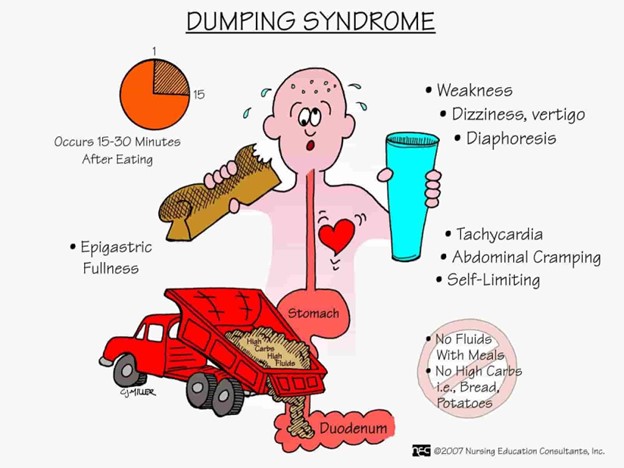The nurse is monitoring a client for the early signs and symptoms of dumping syndrome. Which findings indicate this occurrence?
Sweating and pallor
Abdominal cramping and pain
Double vision and chest pain
Bradycardia and indigestion
The Correct Answer is A
Choice A Reason: Sweating and pallor are early signs and symptoms of dumping syndrome, which is a condition where food moves too quickly from the stomach to the small intestine, causing rapid fluid shifts and hormonal changes. Sweating and pallor are caused by hypoglycemia, which occurs when the high concentration of food in the small intestine stimulates insulin secretion.
Choice B Reason: Abdominal cramping and pain are late signs and symptoms of dumping syndrome, which occur about one to three hours after eating. Abdominal cramping and pain are caused by intestinal distension, spasms, and gas formation.
Choice C Reason: Double vision and chest pain are not signs and symptoms of dumping syndrome, but may indicate other serious conditions, such as stroke or heart attack. Double vision and chest pain should be reported to the provider immediately.
Choice D Reason: Bradycardia and indigestion are not signs and symptoms of dumping syndrome, but may be related to other gastrointestinal disorders, such as gastritis or peptic ulcer disease. Bradycardia and indigestion should be evaluated by the provider for further diagnosis and treatment.

Nursing Test Bank
Naxlex Comprehensive Predictor Exams
Related Questions
Correct Answer is C
Explanation
Choice A Reason: This is correct because incorporating foods rich in vitamin C in the diet can help prevent or delay macular degeneration. Vitamin C is an antioxidant that can protect the cells of the macula, which is the central part of the retina that is responsible for sharp and detailed vision, from oxidative stress and damage. The nurse should also advise the client to consume foods rich in other antioxidants, such as vitamin E, zinc, lutein, and zeaxanthin.
Choice B Reason: This is correct because receiving injections into the eye can help treat macular degeneration. Injections are a form of anti-vascular endothelial growth factor (anti-VEGF) therapy, which can block abnormal blood vessel growth and leakage in the macula that can cause vision loss. The nurse should explain to the client how often and how long they need to receive injections and what side effects or complications they may experience.
Choice C Reason: This is incorrect because vision will not be restored after using eye drops for macular degeneration. Eye drops are not a proven or effective treatment for macular degeneration, which is a chronic and progressive condition that causes irreversible vision loss. The nurse should reinforce education by informing the client that eye drops may only provide temporary relief of dryness or irritation, but they will not improve or restore vision.
Choice D Reason: This is correct because vision will become progressively more blurry with macular degeneration. Macular degeneration can cause blurred or distorted central vision, difficulty reading or recognizing faces, or dark spots in the visual field. The nurse should educate the client on how to cope with vision loss and use adaptive devices, such as magnifiers, large-print books, or voice-activated technology.
Correct Answer is ["A","B","C","D"]
Explanation
Choice A Reason: A distended bladder is one of the most common triggers of autonomic dysreflexia, which is a life-threatening condition that occurs in clients with spinal cord injuries above T-6. The bladder becomes overfilled and stimulates the sympathetic nervous system, causing vasoconstriction and hypertension.
Choice B Reason: A severe headache is one of the most common symptoms of autonomic dysreflexia, caused by the increased blood pressure in the brain. The headache may be accompanied by blurred vision, sweating, flushing, or anxiety.
Choice C Reason: An elevated blood pressure is the hallmark sign of autonomic dysreflexia, which can reach dangerously high levels and cause stroke, seizure, or death. The blood pressure may rise up to 300/160 mmHg or higher.
Choice D Reason: Nasal congestion is another possible trigger of autonomic dysreflexia, as it stimulates the nasal mucosa and activates the sympathetic nervous system. Other potential triggers include bowel impaction, skin irritation, tight clothing, or temperature changes.
Whether you are a student looking to ace your exams or a practicing nurse seeking to enhance your expertise , our nursing education contents will empower you with the confidence and competence to make a difference in the lives of patients and become a respected leader in the healthcare field.
Visit Naxlex, invest in your future and unlock endless possibilities with our unparalleled nursing education contents today
Report Wrong Answer on the Current Question
Do you disagree with the answer? If yes, what is your expected answer? Explain.
Kindly be descriptive with the issue you are facing.
